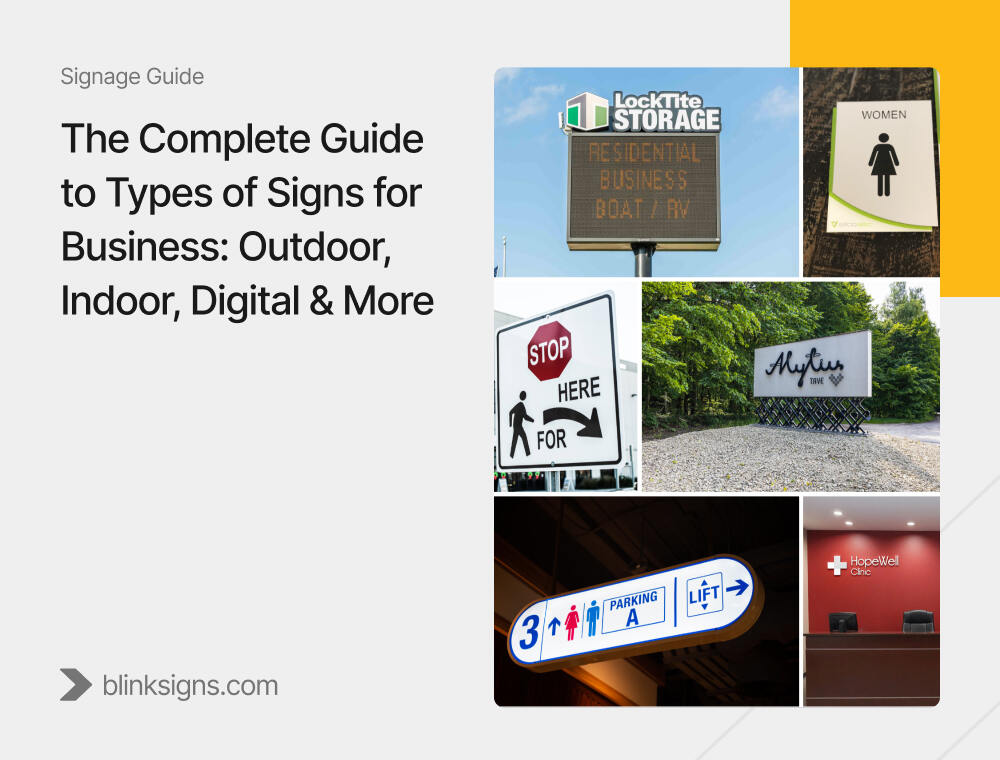
The Complete Guide to Types of Signs for Business: Outdoor, Indoor, Digital & More
Signs do far more than mark a location—they communicate brand identity, guide customers, ensure safety, and boost visibility in a crowded marketplace. Understanding the full spectrum of commercial signs is essential for business owners, facility managers, and marketers.
This guide walks through all the major types of signs and their categories while explaining their uses, and helps you choose what’s right for your goals. Whether launching a new storefront, updating workplace safety, or launching a digital marketing campaign, the proper signage makes a measurable difference.
Why Signs Matter for Businesses and Communities
Signs serve as the first point of contact between your business and potential customers. A well-designed sign attracts foot traffic and reinforces your brand’s professionalism and credibility.
In retail, hospitality, healthcare, education, and industrial settings, signs provide essential information, from directions and hours to promotions and safety alerts.
Beyond functionality, signs contribute to public and private spaces’ aesthetic and navigational flow, impacting overall customer experience and community perception.
Main Categories of Signs
Commercial signs fall into several broad categories, each with unique benefits and applications:
- Outdoor Signs: Designed for maximum visibility and durability, these signs withstand weather and catch the eye of passersby.
- Indoor Signs: Focus on wayfinding, branding, and information within buildings and facilities.
- Digital & Electronic Signs: Offer dynamic content, real-time updates, and interactive experiences.
- Safety & Regulatory Signs: Ensure compliance, protect people, and meet legal requirements.
- Directional & Wayfinding Signs: Help visitors navigate complex environments with ease.
- Promotional & Advertising Signs: Drive sales, highlight offers, and support marketing campaigns.
Understanding these categories sets the foundation for exploring specific sign types and their best uses.
Outdoor Signs: Maximizing Visibility and Brand Impact
Outdoor signage acts as the face of your business to the world. These signs must be resilient, eye-catching, and instantly recognizable, often serving as the first impression for potential customers.

Different types of outdoor signs
- Blade Signs: Mounted perpendicular to a building facade, blade signs project over sidewalks, making them ideal for urban storefronts with high pedestrian traffic. Their unique angle ensures visibility from down the street, guiding customers directly to your door.
- Channel Letters: Three-dimensional letters, typically illuminated with LEDs, spell out your business name or logo. Channel letters offer a modern, professional look, especially effective at night. Customizable in size, color, and font, they reinforce brand identity day and night.
- Monument Signs: Freestanding structures at property entrances, monument signs communicate prestige and permanence. Often constructed from stone, metal, or acrylic, they suit corporate campuses, medical centers, and residential communities seeking a refined appearance.
- Pole Signs: Tall, freestanding signs visible from roads and highways maximize reach for businesses away from the street. Their elevated position makes them a prime choice for retail centers, gas stations, and restaurants relying on drive-by traffic.
- Billboards: Large-format outdoor advertising, billboards dominate high-traffic areas, broadcasting your message to thousands daily. Traditional static billboards offer broad exposure, while digital billboards allow rotating ads and timely promotions.
- Awnings & Canopies: Combining shelter with branding, awnings shade windows and sidewalks while displaying your logo or messaging. They enhance curb appeal and provide practical benefits for both businesses and customers.
- Flags & Banners: Obvious, portable, and cost-effective, flags and banners announce sales, events, or grand openings. Feather and teardrop flags flutter in the breeze, naturally drawing the eye at outdoor venues and along streets.
- Vehicle Wraps & Transit Ads: Turn company vehicles into mobile billboards with full or partial vinyl wraps. Transit ads on buses, trains, and shelters extend your reach into public spaces, capturing attention throughout the community.
Each outdoor sign type addresses a specific communication need, from brand awareness to event promotion. The right choice depends on your location, audience, and marketing objectives.
Indoor Signs: Enhancing Navigation, Experience, and Branding
While outdoor signs create first impressions, indoor signs shape the customer journey, reinforce brand identity, and ensure smooth, accessible navigation. From lobby directories to digital menu boards, indoor signage is vital in retail, hospitality, healthcare, office, and educational environments.
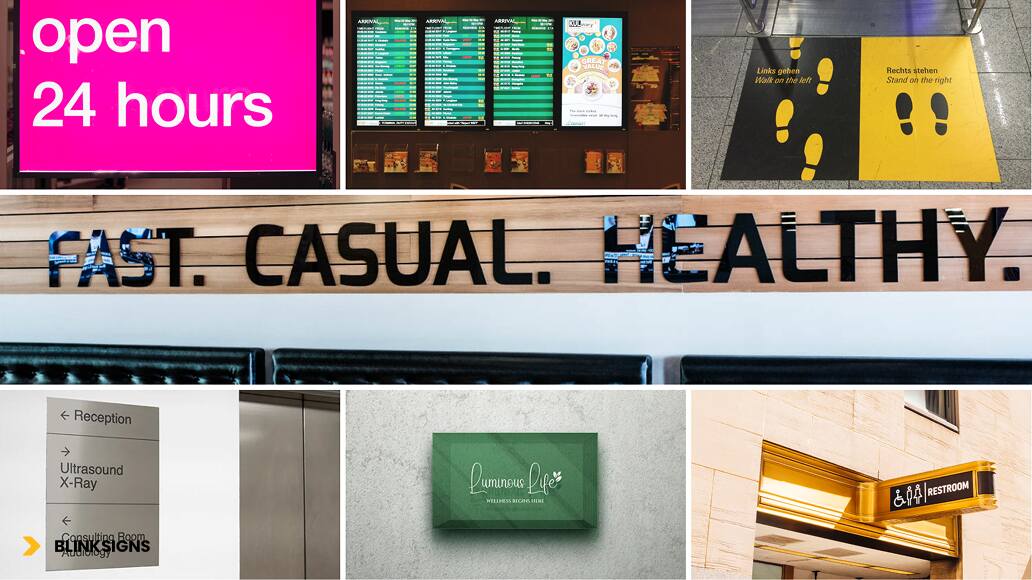
Different types of indoor signs
Why Indoor Signage Matters
Indoor signs guide visitors through unfamiliar spaces, highlight key information, and subtly reinforce your brand at every touchpoint. Poorly designed or absent signage leads to confusion, frustration, and missed opportunities—whether for sales, safety, or customer satisfaction. The right indoor signs create clarity, confidence, and a sense of welcome.
Core Types of Indoor Signs
Below is a detailed table outlining the main types of indoor signs, their typical uses, key features, and benefits for businesses. This structure helps readers quickly compare options and identify the best fit for their needs.
| Sign Type | Typical Use Cases | Key Features | Main Benefits |
| Lobby & Reception | Offices, hotels, clinics, corporate facilities | Custom branding, company logos, business messages | Professional image, visitor orientation, brand reinforcement |
| Directory Sign | Large buildings, malls, hospitals, campuses | Lists tenants, departments, offices, or services | Efficient wayfinding, reduced confusion, better visitor flow |
| Wall Mounted Sign | Retail stores, offices, clinics | Mounts directly to walls for visibility | Brand visibility, space-saving, flexible placement |
| Countertop Sign | Retail, restaurants, service counters | Small, portable, and often displays promotions | Drives impulse buys, highlights offers, and easy updates |
| Shelf Sign | Retail, supermarkets, libraries | Tag products, prices, or specials on shelves | Clear pricing, promotions at point of decision, organized displays |
| Poster Stand/Easel | Promotions, events, temporary messaging | Freestanding, easy to move, eye-catching graphics | Flexible marketing, seasonal promotions, event awareness |
| Floor Sign | Directional, promotional, safety | Applied directly to flooring, durable materials | Guides foot traffic, promotes safety, highlights deals |
| Digital Menu Board | Restaurants, cafes, quick-service | Dynamic, remotely updated, colorful displays | Easy menu changes, eye-catching visuals, upselling opportunities |
| Interactive Touchscreen | Self-service kiosks, directories, info points | Touch-enabled, multimedia content | Reduces staff workload, enhances user experience, delivers real-time info |
| Informational Sign | Hours, policies, facility rules, Wi-Fi info | Clear, concise text, easy to read | Keeps customers informed, sets expectations, supports operations |
Choosing the Right Indoor Signs
Directories and wayfinding signs are essential in complex environments—think hospitals, universities, or shopping malls—where visitors need clear directions to their destination. A well-designed directory reduces frustration and improves the overall experience, which can translate to higher customer satisfaction and repeat visits.
Wall-mounted and lobby signs set the tone when someone enters your space. These signs communicate your brand’s personality and professionalism through sleek dimensional letters, illuminated logos, or minimalist acrylic panels.
Retail-focused signs like countertop displays, shelf talkers, and easel posters drive sales by highlighting promotions, new products, or limited-time offers at the point of decision. These signs are cost-effective and easy to update, making them ideal for dynamic retail environments.
Digital signage—including menu boards and interactive kiosks—offers flexibility and engagement. Digital signs can be updated instantly, display multimedia content, and even collect customer feedback. They’re especially valuable in food service, entertainment, and hospitality, where menus and promotions change frequently.
Informational and safety signs ensure compliance, communicate policies, and keep everyone safe. From ADA-compliant tactile signs to emergency exit indicators, these signs are not just a legal requirement but a mark of responsible business practice.
Indoor Signage Trends
Advancements in materials, lighting, and connectivity are transforming indoor signage. LED backlighting, touchscreen interactivity, and real-time content updates allow businesses to create immersive, responsive environments. Eco-friendly materials and modular designs are also gaining traction, appealing to sustainability-conscious brands and customers.
Indoor Sign Types at a Glance
| Category | Example Sign Types | Best For | Key Advantage |
| Wayfinding | Directory, floor decals, arrow signs | Complex buildings, public spaces | Reduces confusion, improves flow |
| Branding | Lobby, wall mounted, reception | Offices, retail, hospitality | Reinforces brand, professional image |
| Promotional | Countertop, shelf, poster stand | Retail, restaurants, events | Drives sales, easy to update |
| Digital | Menu board, touchscreen kiosk | Food service, retail, self-service | Dynamic content, real-time updates |
| Informational | Hours, policies, facility info | All businesses | Keeps customers informed |
| Safety/Compliance | ADA, emergency, fire safety signs | Workplaces, public facilities | Meets legal requirements, protects people |
Digital & Electronic Signs: Captivating Audiences with Innovation
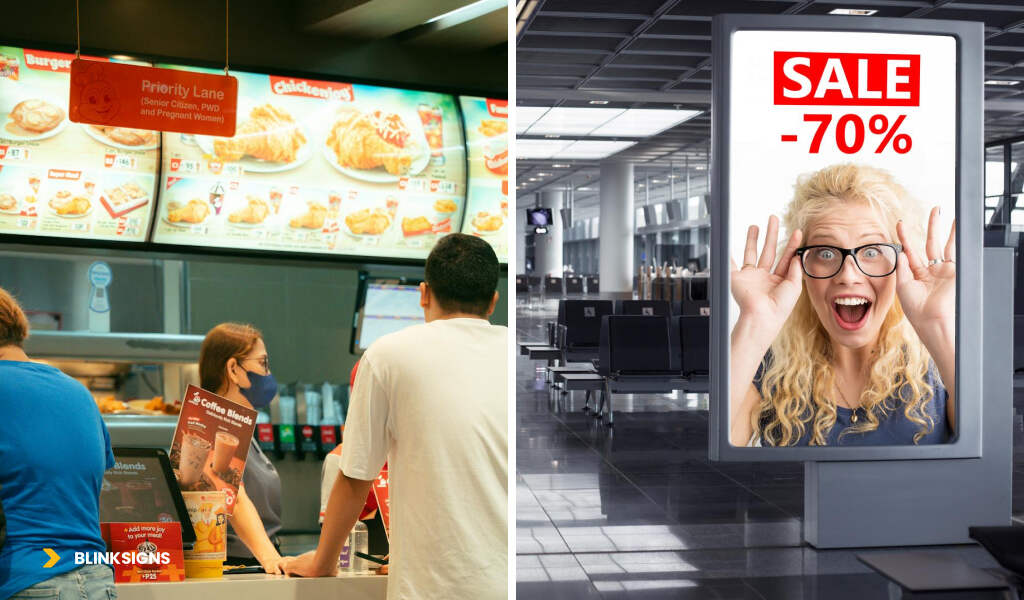
Digital & Electronic Signs_ Captivating Audiences with Innovation
Unlock your business’s potential with digital and electronic signage—the game-changers in engagement, flexibility, and instant communication. While traditional signs show your message, digital signs make it move, grow, and interact with your audience, offering unmatched opportunities to stand out and build deeper connections.
Why Switch to Digital & Electronic Signs?
Gone are the days of static signage. Today’s customers expect eye-catching, up-to-the-minute content—and digital signs deliver just that, while offering powerful benefits for business owners and visitors.
- Instant Updates, Maximum Impact—Change promotions, menus, or event announcements in real time—no more posters in the trash or frustrated employees swapping out outdated signs. Digital displays adjust instantly to your marketing needs, special events, or even the time of day.
- Dynamic Visuals that Captivate—Motion, color, and multimedia content grab attention far longer than traditional signs. Digital screens can showcase videos, live feeds, social media content, and even user-generated testimonials—keeping your messaging fresh and engaging.
- Interactivity Drives Engagement—Touchscreens and kiosk displays invite customers to interact, browse products, get directions, or leave feedback directly on your signage, transforming passive viewers into active participants.
- Bright Signage and Connected Experiences—Integrate digital signs with your online marketing, social channels, and POS system. Show real-time inventory, highlight the latest reviews, or sync promotions across all your locations for a seamless brand experience.
- Long-Term Savings—While the upfront investment may be higher, digital signs eliminate printing and installation costs for every new message, and often pay for themselves over time.
Direct, Side-by-Side Comparison: Digital vs. Traditional Signs
| Feature | Traditional Signs | Digital & Electronic Signs |
| Content Updates | Manual (time-consuming, costly to change) | Instant, remote, and flexible |
| Visual Impact | Static, limited colors, flat graphics | Dynamic, vibrant, video, motion, interactivity |
| Engagement | One-way communication | Two-way, interactive, even immersive experiences |
| Maintenance | Replace entire sign for updates | Update content on demand—no physical replacement |
| Customization | Infrequent, costly | Easy, frequent, and tailored to audience/occasion |
| Cost Over Time | Ongoing print/install expenses | Mostly upfront, less recurring expense |
Real-World Applications: Where Digital Signs Shine
- Retail: Rotate daily deals, showcase new arrivals, and greet customers by name with personalized messaging.
- Food Service: Update menus instantly for seasonal specials, dietary options, or real-time inventory.
- Healthcare: Streamline check-in, display wait times, and communicate important health alerts.
- Education: Broadcast campus events, emergency notifications, and digital directories.
- Corporate: Welcome visitors, announce company news, and create immersive digital Art displays in lobbies and conference rooms.
- Restaurants—Digital menu boards let you highlight chef’s specials, promote combo deals, and easily comply with menu labeling laws—all without reprinting.
- Retailers—Interactive kiosks guide shoppers to products, offer digital coupons, and collect customer feedback on the spot.
- Event Venues—Display live schedules, social media feeds, and sponsor messages, keeping attendees engaged from arrival to departure.
Why Your Business Needs Digital Signage
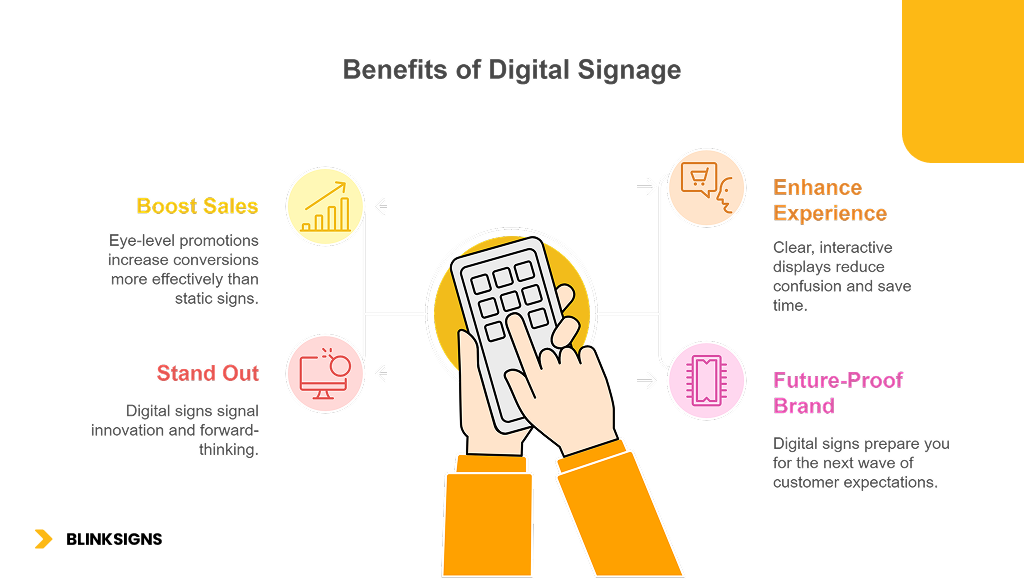
Benefits of digital signage_ infographics by BlinkSigns
- Boost Sales & Impulse Purchases—Eye-level digital promotions increase conversions more effectively than static signs. Shelves and countertops with digital tags can drive last-minute decisions.
- Enhance Customer Experience—Clear, interactive displays reduce confusion, save time, and make visits smoother—customers notice when a business is easy and enjoyable to navigate.
- Stand Out from Competitors—Digital signs signal innovation and forward-thinking. Even in crowded markets, dynamic displays get noticed and remembered.
- Future-Proof Your Brand—As customers expect more digital interaction, digital signs prepare you for the next wave of customer expectations—voice commands, AI-driven personalization, and instant mobile connectivity are already on the horizon.
Choosing the Right Digital Signage for Your Business
- Assess Your Goals: Start with clear objectives—drive sales, improve wayfinding, enhance brand image, or inform visitors?
- Know Your Audience: What engages your customers? Retailers might focus on promotions, museums on interactivity, and offices on communication.
- Consider Location & Size: High-traffic areas benefit from large, vibrant displays; intimate spaces suit interactive kiosks.
- Partner With Experts: Work with a signage provider like Blinksigns.com to design, install, and manage your digital solution—ensuring reliability, security, and seamless integration with your brand.
Ready to Captivate Your Customers?
Digital and electronic signage isn’t just an upgrade—it’s an investment in your brand’s relevance and resilience. With the power to inform, persuade, and delight, digital signs transform everyday interactions into memorable experiences. Whether you want to sell more, serve better, or simply stand out, digital signage delivers measurable results—with flexibility and flair that grows with your business.
Safety, Regulatory & ADA-Compliant Signs: Protect People, Build Trust, and Stay Compliant
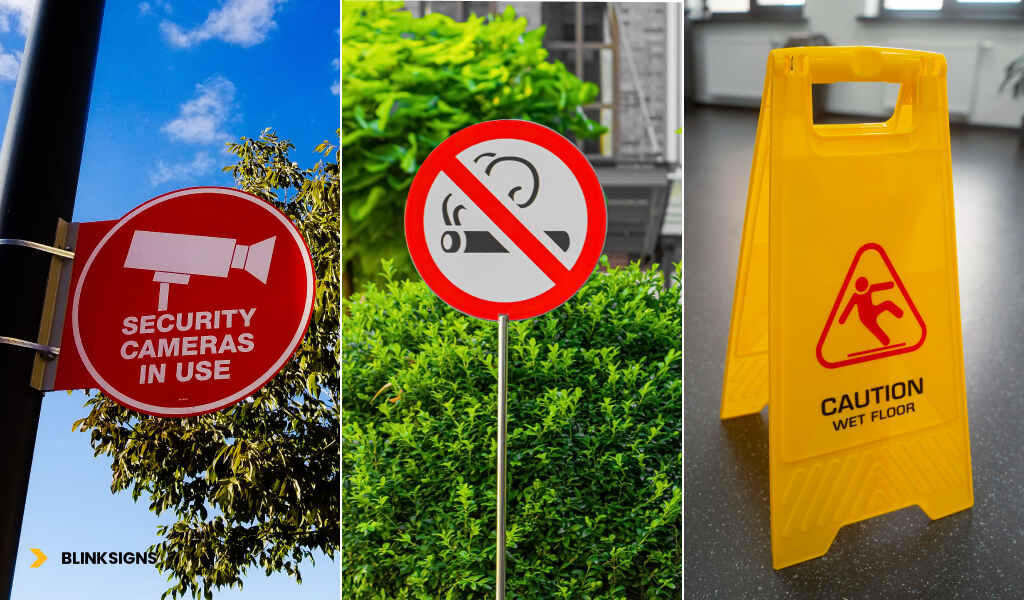
Safety, Regulatory & ADA-Compliant Signs
Signs keep people safe, guide behavior, and meet legal requirements—two reasons no business can afford to overlook safety, regulatory, and accessibility signage.
These signs aren’t just about rules but respect, responsibility, and care for employees, visitors, and the community.
Investing in clear, correctly positioned safety signage demonstrates professionalism and protects your business from liabilities, accidents, and regulatory missteps.
Why Safety, Regulatory, and ADA Signs Matter
- Liability and Legal Compliance: Proper signage helps your business meet Occupational Safety and Health Administration (OSHA), Department of Transportation (DOT), Americans with Disabilities Act (ADA), and local regulations. Failure to comply can mean fines, lawsuits, or even shutdowns.
- Accident Prevention: Well-placed safety and warning signs reduce workplace and public accidents, protecting people and your reputation.
- Accessibility for All: ADA-compliant signs ensure everyone, including those with disabilities, can navigate your facility safely and independently.
- Brand Reputation: Safety-conscious organizations earn trust from customers, employees, and partners. Good signage shows you care—about safety, law, and inclusion.
Essential Safety, Regulatory, and ADA Sign Types
| Sign Category | Example Signs | Purpose & Use Cases | Key Benefits |
| Prohibition Signs | No Entry, No Smoking | Prevent unauthorized actions and hazards | Enforce rules, reduce risks |
| Warning Signs | Caution, Danger, Slippery | Alert people to potential hazards and dangers | Prevent accidents, injuries |
| Mandatory Signs | Ear Protection, Wash Hands | Specify required actions for safety | Ensure compliance, protect health |
| Emergency Exit Signs | Exit, Fire Exit, Arrow | Indicate escape routes during emergencies | Save lives in critical situations |
| Fire Equipment Signs | Fire Extinguisher, AED | Mark locations of emergency equipment | Enable fast response during crises |
| ADA-Compliant Signs | Braille, Tactile, Pictogram | Ensure accessibility for people with disabilities | Meet legal requirements, inclusivity |
| Regulatory Signs | OSHA, DOT, ISO Symbols | Communicate legal and industry requirements | Keep facilities safe and compliant |
Bringing Safety, Regulatory, and ADA Signs to Life
- Prohibition Signs—Bright, bold signs like “No Smoking,” “No Entry,” or “Authorized Personnel Only” make rules unambiguous. These signs use red circles with diagonal lines to signal prohibition and help maintain orderly, secure environments.
- Warning Signs—Yellow triangles or orange diamonds alert people to hazards like slip risks, high voltage, or chemical storage. These signs are critical in manufacturing, warehousing, and construction—anywhere danger lurks.
- Mandatory Signs—Blue circles with white symbols communicate actions people must take—wear protective gear, wash hands, or use earplugs. These signs help prevent injuries and health violations.
- Emergency Exit and Fire Equipment Signs—Green signs with arrows and symbols direct people to safety, mark fire exits, and show where to find extinguishers or first aid kits. In emergencies, these signs save precious seconds—and lives.
- ADA-Compliant Signs—These signs feature raised tactile text, Braille, high-contrast colors, and clear pictograms. They’re required for restrooms, exits, and accessible entrances. Good design ensures people with vision or mobility challenges know where to go.
- Regulatory Road and Parking Lot Signs—Stop, yield, handicap parking, and speed limit signs keep traffic moving safely and fairly—critical for visitor and employee safety.
Persuasive Reasons to Invest in Quality Safety & Accessibility Signs
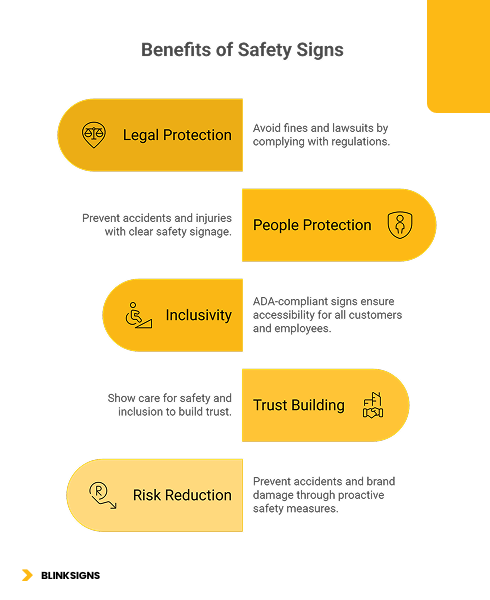
Benefits of safety signs
- Stay Out of Legal Trouble—Non-compliance with OSHA, ADA, and other regulations can trigger fines and lawsuits. Keep your business protected.
- Protect Your People—Clear signage prevents accidents, injuries, and costly downtime.
- Welcome, Everyone—ADA-compliant signs make your business accessible to all customers and employees, not just some.
- Build Trust—Customers, partners, and top talent favor companies that visibly care about safety and inclusion.
- Reduce Risk—Prevention is always less expensive than accidents, litigation, and brand damage.
Best Practices for Effective Signage
- Place Signs Where Eyes Go First—Install at eye level, near hazards, and all decision points (exits, bathrooms, direction changes).
- Keep Messages Clear and Simple—Use universally recognized symbols and concise text.
- Maintain and Inspect Regularly—Promptly replace faded, damaged, or out-of-date signs.
- Work With Experts—Partner with signage professionals who understand your industry’s regulations and can help you avoid costly oversights.
- Train Staff—Ensure employees know what each sign means and how to respond in an emergency.
Summary Table: Safety, Regulatory & ADA Signs
| Category | Example Signs | Why They Matter | Visual Cues |
| Prohibition | No Smoking, No Entry | Prevent unauthorized actions/hazards | Red circle with diagonal bar |
| Warning | Caution, Danger | Alert to hazards | Yellow triangle, orange diamond |
| Mandatory | Ear Protection, Wash Hands | Enforce required actions | Blue circle, white symbol |
| Emergency Exit | Exit, Fire Exit | Show escape routes | Green, white arrow/symbol |
| Fire Equipment | Fire Extinguisher, AED | Mark emergency resources | Red, white symbol |
| ADA-Compliance | Restroom, Accessible Entry | Ensure accessibility | Tactile, Braille, pictogram |
| Regulatory | Stop, Yield, Speed Limit | Communicate legal rules | Industry-standard shapes/colors |
Conclusion
Safety, regulatory, and ADA-compliant signs are not optional but foundational to responsible business operations. They protect people, prevent accidents, ensure compliance, and signal your commitment to a safe, inclusive environment.
These signs are as crucial for business owners and facility managers as any marketing or wayfinding investment. When you get them right, you protect your people, brand, and bottom line—so make sure your signage is clear, current, and compliant.